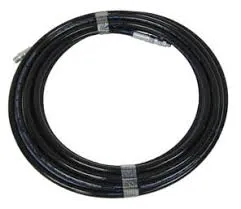power steering hose o ring
Understanding Power Steering Hose O-Rings Importance and Maintenance
Power steering systems have revolutionized the way we navigate vehicles, providing ease of control and a smoother driving experience. An essential component of this system is the power steering hose, which transports hydraulic fluid from the pump to the steering gear. However, this system relies on several smaller components to function efficiently, one of which is the O-ring. This article delves into the importance of power steering hose O-rings, their function, potential issues, and maintenance tips to ensure long-lasting performance.
What is an O-Ring?
An O-ring is a circular sealing element made from various materials, such as rubber, silicone, or polyurethane. Its primary purpose is to prevent fluid leaks in hydraulic and pneumatic applications. In the context of power steering systems, O-rings are strategically placed at the junctions between hoses and fittings, ensuring that hydraulic fluid remains contained within the system, providing the necessary pressure for steering.
The Role of Power Steering Hose O-Rings
In the power steering system, O-rings perform several critical functions
1. Sealing The most crucial role of O-rings is to create a tight seal that prevents hydraulic fluid from leaking out of the hoses and fittings. This sealing capability is vital for maintaining the pressure within the system, which is essential for effective steering.
2. Flexibility O-rings can accommodate slight movements and vibrations that occur within the steering system. This flexibility is particularly important, as the power steering mechanism is exposed to a range of temperatures and pressures during operation.
3. Durability High-quality O-rings are designed to withstand the harsh conditions characteristic of automotive environments. They resist degradation from exposure to hydraulic fluids and other contaminants, ensuring a long service life.
Common Issues with O-Rings
Despite their durability, O-rings can wear out or become damaged over time. Several factors can contribute to O-ring failure
1. Aging and Fatigue Over time, exposure to heat, pressure, and hydraulic fluid can cause O-rings to harden, crack, or become brittle. This aging process can lead to a compromised seal and potential fluid leaks.
power steering hose o ring

2. Improper Installation If an O-ring is not installed correctly, it may become pinched or misaligned when the fittings are connected. This can lead to leakage at the joint, undermining the efficiency of the power steering system.
3. Contamination Dirt, debris, or the presence of incompatible fluids can deteriorate O-rings. Such contamination can weaken the material, leading to premature failure.
4. Pressure Issues Excessive pressure within the power steering system can cause O-rings to deform. If the system is not designed to handle high pressure, it can result in leaks or system failures.
Maintenance Tips for O-Rings
To prolong the life of power steering hose O-rings and maintain the integrity of the power steering system, consider the following maintenance tips
1. Regular Inspections Periodically check for signs of leaks around the power steering hoses and fittings. Early detection of fluid leakage can help prevent more extensive damage to the steering system.
2. Proper Replacement When replacing O-rings, always use high-quality, manufacturer-recommended parts to ensure compatibility and performance. Ensure that old O-rings are completely removed before installing new ones.
3. Avoid Over-tightening When connecting hoses and fittings, avoid over-tightening, which can stress or damage O-rings, leading to leaks.
4. Keep the Area Clean Regularly clean the area around the power steering system to prevent contamination from dirt and debris. If working on the system, ensure your hands and tools are clean to avoid introducing foreign substances.
Conclusion
Power steering hose O-rings may seem like minor components within the broader power steering system, but their function is crucial for maintaining effective steering and preventing leaks. Understanding their role and keeping up with regular maintenance can enhance the longevity and performance of your vehicle's steering system. By prioritizing the health of these small but essential components, drivers can enjoy a smooth and responsive driving experience for years to come.
-
Ultimate Spiral Protection for Hoses & CablesNewsJun.26,2025
-
The Ultimate Quick-Connect Solutions for Every NeedNewsJun.26,2025
-
SAE J1401 Brake Hose: Reliable Choice for Safe BrakingNewsJun.26,2025
-
Reliable J2064 A/C Hoses for Real-World Cooling NeedsNewsJun.26,2025
-
Heavy-Duty Sewer Jetting Hoses Built to LastNewsJun.26,2025
-
Fix Power Steering Tube Leaks Fast – Durable & Affordable SolutionNewsJun.26,2025

